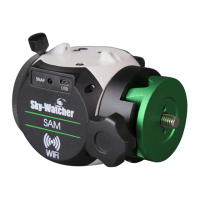Astro Time-Lapse
Astro Time-Lapse photography faces the same challenges as astrophotography
in general. Namely, due to the dimness of the subject (the night sky), longer
exposures are required to record sucient detail, and tracking is needed to
prevent star trailing during those exposures. But there are some dierences
as well.
For astrophotography, the region of sky that is being photographed moves
over the course of the exposure sequence. We generally repeat the process
to obtain a sequence of images, all of the same subject, and all framed
idencally. This means that our camera is poinng in a dierent direcon at
the end of the sequence compared to where it was poinng at the beginning.
This occurs because our subject has moved and the camera has moved along
with it.
In Astro Time-Lapse we take mulple images as well, and the camera moves
with each exposure. But, unlike in astrophotography, SAM returns the camera
to the starng point aer each exposure is completed.
Now, when the frames are sequenced into a video, you see the night sky
moving about a xed terrestrial reference point. By nding locaons with
beauful foreground sengs you can produce breathtaking videos of the sky
moving over your locaon. [Visit our YouTube channel to see some examples].
Special Requirements For Astrophotography and Astro Time-Lapse
In order to track the movement of the night sky the camera has to be
connuously moved to oset the rotaon of the Earth in order to hold the
subject perfectly steady on the sensor. The rotaon of the camera needs to
take place about an axis that is parallel to Earth’s rotaonal axis, and therefore,
the two axes must be aligned in order for tracking to work correctly.
A me-lapse video consists
of hundreds to thousands
of individual photos taken
over a long span of me
then replayed in a short
video, revealing natural
dynamics that occur much
to slowly for us to perceive
otherwise.
18

